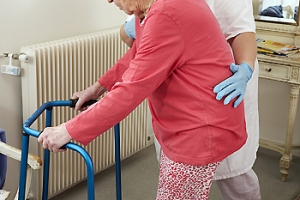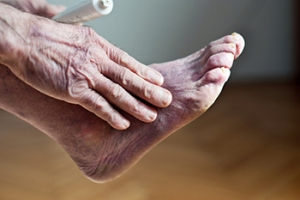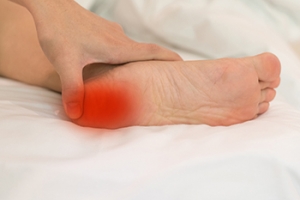Super User
Preventing Falls in Senior Citizens
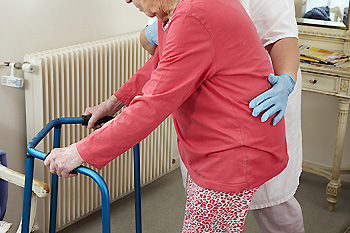
If you are a senior citizen, then you are at an increased risk of suffering a potentially dangerous fall. Falls can detrimentally affect the health of older individuals and lead to subsequent falls. However, there are a number of steps that seniors can take to prevent such dangerous episodes. Many of these steps involve the feet. For example, to prevent yourself from falling, you might be cognizant of the kinds of footwear that you are wearing. Generally speaking, high heels can make falling more likely. Instead, seniors might opt for footwear that has lower heels. You could even try shoes with non-slip soles. Shoes that have wider heels are also another good option for increasing stability and balance in the feet. Besides being intentional about the kinds of shoes that you wear, seniors can also prevent falls by engaging in regular exercise. This should be done to keep the feet strong and agile, so that they do not grow weak or unhealthy. For more tips on preventing falls in senior citizens, visit a chiropodist who can help.
Falls are a common but preventable problem for older adults. If you would like to learn more about preventing falls, please consult with one of the chiropodists from The Footcare Centre. Our chiropodists can help you maintain the health of your lower limbs and your mobility.
Did you know that most falls occur in the home? Fortunately, there are many simple changes that you can make to the living environment to reduce the risk of falling.
In the Bathroom:
Install grab bars near toilets, bathtubs, and showers
Put non-skid mats on all surfaces that may get wet
In the Bedroom:
Keep a light near the bed so that you can easily turn it on if you have to get up at night
Keep the path from your bedroom to the bathroom clutter-free and well-lit
Consider installing a bed rail for added support
In the Kitchen:
Use non-skid mats
Wipe up any spills immediately
Move commonly used items to areas that are easily within your reach
In the Hallways:
Place handrails on both sides of the stairs
Install good lighting in the hallways and around the entire home
Keep hallways free of clutter
Don’t use throw rugs or small area rugs
In Other Living Areas:
Keep loose cables, cords, and wires near the wall and away from walking surfaces
Make sure that all carpets and rugs are secure firmly to the floor
Arrange your furniture so that it is not in your way when you walk
Use chairs and couches that you can easily get up from
If you have any questions, please feel free to contact our office located in . We offer the newest diagnostic and treatment technologies for all your foot care needs.
Falls Prevention
Many older adults think that falls are rare and won’t happen to them, so they don’t need to take steps to reduce the risk of falling. This isn’t true, as falls are very common. Falls are one of the leading causes of serious injuries and disabilities among older adults. Not only does falling affect one’s physical health, but it can also cause psychological harm. An older adult who has fallen may lose confidence in their abilities to get around and live independently. They may feel that the only ways to prevent falling are to avoid physical activities and stay in the house when this can in fact be counterproductive.
Though staying in the house can be tempting for an adult that is afraid of falling, it’s worthwhile to note that over 50% of all falls occur in the home. A better way to prevent falls is to take steps to make your home safer. Remove tripping hazards, like loose cables, slippery rugs, and low furniture from the home. Install good quality lighting that will allow you to see where you are walking. In the bathrooms, use a non-slip bath mat and install grab bars in the shower to avoid slipping. When you do leave the house, don’t be ashamed to use a mobility aid, such as a cane, if necessary.
Reducing the risk of falling continues with taking care of one’s physical health. Exercising regularly and incorporating exercises that stretch and strengthen the lower limbs is important for maintaining mobility. Vision care is another key element of falls prevention, as people with vision impairment are more than twice as likely to fall than those who don’t have vision problems. Being able to clearly see where you are going and if there are any tripping hazards in your way will help prevent falls. Managing your medications can help prevent falls. Certain medications cause side effects that impair balance, leading to falls. You should talk to your doctors about the medications that you are currently taking, their side effects, and any ways that they may interact with one another. Finally, regularly seeing a chiropodist can help maintain your foot health and mobility. A chiropodist can not only treat any existing foot problems, which can contribute to falling, but also help you prevent future issues.
Poor Blood Circulation and the Feet
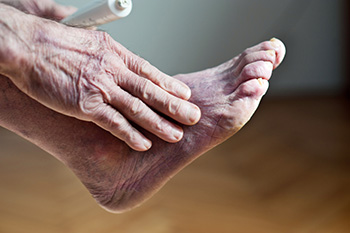
The body’s circulation system sends blood, oxygen, and nutrients through the body. When blood flow to a specific body part is reduced, it is called poor circulation. This can happen with the feet. Poor circulation is not the condition itself, but what results from poor circulation that causes other health problems. Underlying conditions that can result in poor circulation to the feet include obesity, diabetes, heart conditions, and arterial disease. When one has poor blood circulation in the feet they might experience tingling, numbness, a throbbing or stinging pain, muscle cramps, nerve damage, and ultimately tissue damage. People with diabetes can have difficulty detecting signs of poor blood circulation because diabetic neuropathy might set in and cause reduced sensation to the extremities. Since poor blood circulation is a symptom of numerous conditions, diagnosing the underlying cause is important. If you have diabetes or experience the other symptoms of poor blood circulation, visit a chiropodist for help in determining what the problem is and how to best treat it.
When blood flow to a specific part of the body is reduced, you may experience symptoms of poor circulation. Poor circulation is most common in your extremities, like your legs and feet. Please consult with one of the chiropodists from The Footcare Centre. Our chiropodists will assess your condition and provide you with quality foot and ankle treatment.
Causes
Poor circulation isn’t a condition in itself. Instead, it results from other health issues. Therefore, it’s important to treat the underlying causes:
Peripheral artery disease (PAD)
Diabetes
Blood clots
Varicose veins
Obesity
Raynaud’s disease
Symptoms
Symptoms of poor circulation may include:
Numbness
Tingling
Throbbing or stinging pain in limbs
Pain
Muscle Cramps
Diagnosis
A chiropodist will perform a physical exam to detect pain and swelling, as well as an antibodies blood test to detect inflammatory conditions, such as Raynaud’s disease. It’s important to disclose any known family history of poor circulation and any related diseases. A blood sugar test, blood pressure test, ultrasound, or CT scan may also be performed.
Treatment
Treatments for poor circulation depend on what is causing it. Compression socks may be used to reduce pain and swelling. An exercise program may be recommended to improve circulation. Various medications may be prescribed to manage underlying conditions that may contribute to poor circulation.
If you have any questions, please feel free to contact our office located in . We offer the newest diagnostic and treatment technologies for all your foot care needs.
Poor Circulation
Poor circulation refers to inadequate blood flow to an area of the body. Poor circulation to the lower limbs can be a particularly dangerous condition that can cause complications such as blood clots, chronic pain, swelling, mobility difficulties, infections, and amputations.
The symptoms of poor circulation in your lower legs and feet include coldness, tingling, numbness, or a “pins and needles” sensation. Your legs and feet may also feel painful, achy, or heavy. The skin may turn blue or purple, stop growing hair, and become easily damaged. Cuts, scrapes, and sores on the feet can develop into poorly healing wounds, which are at risk of infection.
Poor circulation can be more likely depending on various genetic, lifestyle, and medical factors. People who are older, live a sedentary lifestyle, or are obese are at an increased risk of poor circulation. Diseases such as diabetes, deep vein thrombosis, atherosclerosis, peripheral artery disease, and venous insufficiency can also make poor circulation more likely to occur.
If you are experiencing symptoms of poor circulation in your lower legs and feet, it is recommended that you see a chiropodist for treatment.
Injuries and Conditions Common Among Runners

If you run long enough and frequently enough, it is likely that you will sustain an injury to your feet and ankles. Among the most common running-related foot and ankle injuries are ankle sprains, plantar fasciitis, stress fractures, and Achille tendonitis. An ankle sprain occurs when you land on the outside of the foot and roll your ankle over. This type of injury is common in trail runners. Once you sprain an ankle, the joint becomes more susceptible to future injury, so immediate care giving the joint ample time to heal is important. Plantar fasciitis is the inflammation of the band of tissue that runs along the sole of the foot. The plantar fascia is more likely to tear from overuse, such as when you increase running time or distance too quickly. Tight or weakened calf muscles can also be a factor. Stress fractures are hairline cracks in the bones of the midfoot, heel and lower leg. They are the result of repetitive stress or impact and should be attended to as soon as possible. Achilles tendonitis is the inflammation of the tendon that connects the heel to the leg bone, which if ignored can lead to a rupture. If you are a dedicated runner, it is a good idea to schedule regular visits to a chiropodist who can monitor the condition of your feet and ankles and treat any injuries you may incur.
Injuries to the foot and ankle are very common among athletes. If you have experienced an injury, please consult with one of the chiropodists from The Footcare Centre. Our chiropodists will assess your condition and provide you with quality foot and ankle treatment.
Common Injuries Among Athletes:
Achilles tendon injuries
Ankle strains or sprains
Plantar fasciitis
Fractures
Turf toe
Joint dislocations
Sever’s disease
Morton’s neuroma
Symptoms
Symptoms will depend on the cause and severity of the injury. Common symptoms for a foot or ankle injury include pain, swelling, tenderness, bruising, a reduced range of motion, and difficulty bearing weight or walking on the affected foot or ankle.
Diagnosis
Sports injuries are typically diagnosed after carefully examining the affected foot or ankle. This includes moving the injured area to test its range of motion. Medical history will need to be provided, as well as detailed information about how the injury occurred. Imaging studies, such as X-rays or MRIs, may be used to confirm or rule out certain diagnoses.
Treatment
Just like symptoms, treatment will depend on the type of injury and its severity. Initial treatment for many sports injuries is aimed at controlling inflammation and promoting the healing response. The acronym R.I.C.E is a helpful guide to implement for most acute injuries. This method involves resting, icing, compressing, and elevating the affected foot or ankle. In addition, anti-inflammatory medications may be administered and orthotic devices may be prescribed. For more severe injuries, surgery may be required. Lastly, rehabilitation or physical therapy may be needed to gain full functionality in the afflicted area.
If you have any questions, please feel free to contact our office located in . We offer the newest diagnostic and treatment technologies for all your foot care needs.
Why Plantar Fasciitis Is So Common
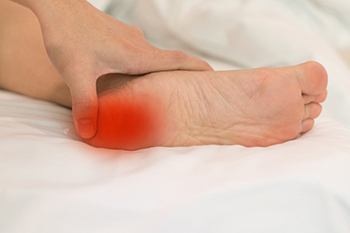
Heel pain is an issue many Americans face every day. In fact, it is the most common form of heel pain. Why? The plantar fascia tissue on the bottom of your feet works hard. It connects your heel bone with your toes, helps form and support the arch, acts as a shock absorber, and is constantly contracting and lengthening as we walk, run, and jump. This hard-working tissue can become damaged or even torn from overuse, thus causing pain and inflammation in the heel referred to as plantar fasciitis. If you have plantar fasciitis you will most likely feel pain throughout the day, but it is particularly acute first thing in the morning. There are things you can do to help avoid the development of plantar fasciitis, such as wearing shoes that fit properly and maintaining a healthy body weight. Consult with a chiropodist for more preventative tips on how to avoid plantar fasciitis, or to receive treatment for this painful condition.
Plantar fasciitis can be painful and interfere with your daily activities. If you are experiencing foot or heel pain and believe you may be afflicted with plantar fasciitis, please consult with one of the chiropodists from The Footcare Centre. Our chiropodists will assess your condition and provide you with quality foot and ankle treatment.
What Is Plantar Fasciitis?
Plantar fasciitis refers to the inflammation of the plantar fascia, a ligament that runs along the bottom of the foot and connects the heel bone to the toes. Repetitive activities, such as running or jumping, can injure the plantar fascia over time. Plantar fasciitis can also be caused by flat feet, high arches, pregnancy, and activities that put excessive pressure on your feet, like standing all day for work. When the plantar fascia becomes inflamed, it causes pain and discomfort.
Symptoms
Typical symptoms of plantar fasciitis include:
Stabbing pain near the heel
Pain that is worst in the morning or after a period of rest
Pain that increases after exercising
Swelling
Tightness in the Achilles tendon
Diagnosis
Plantar fasciitis is typically diagnosed via medical history and physical examination.
Treatment
Treatments for plantar fasciitis include resting and icing the affected foot, stretching the foot, taking medications to reduce inflammation, and wearing orthotics. In severe cases where pain does not improve with conservative treatments, injections or surgery may be recommended.
If you have any questions, please feel free to contact our office located in . We offer the newest diagnostic and treatment technologies for all your foot care needs.
Plantar Fasciitis
The plantar fascia is a thick ligament that runs along the bottom of your foot and connects the heel bone to the toes. When the plantar fascia becomes inflamed, typically due to overuse, it can cause a condition called plantar fasciitis. Plantar fasciitis is characterized by a sharp, stabbing heel pain, arch pain, and pain that is at its worst when taking your first steps after a long resting period, such as when you first wake up in the morning. You may also notice swelling on the bottom of the heel.
Plantar fasciitis is one of the most common foot ailments, and one of the most common causes of heel pain. Besides overuse from activities such as running or jumping, wearing shoes that do not have adequate cushioning and support, standing for prolonged periods of time, being obese, or having flat feet can all increase your risk of developing plantar fasciitis.
Fortunately, there are many treatments for this condition. Your chiropodist may recommend stretching exercises, activity and footwear changes, and icing the affected foot to help relieve pain. If pain persists after several weeks, your chiropodist may prescribe custom orthotics, pad, tape, strap, or immobilize the affected foot, or inject a corticosteroid into the area to reduce pain.
For more information about plantar fasciitis, please consult with a chiropodist.
Possible Complications From a Broken Foot
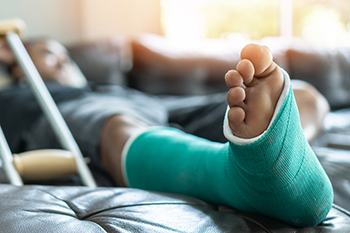
When people break a foot, they are mostly unaware of the complications that may occur. These include a failure to completely heal, and surgery may be required to repair the bone and surrounding areas. Additionally, arthritis may develop if the fracture line enters a joint surface, and an open wound from a fracture may become infected. In cases where the foot is crushed, considerable swelling may develop. This may lead to a condition that is known as compartment syndrome. This may affect the patient’s normal blood pressure, and blood flow may be decreased to parts of the foot. A broken foot is diagnosed by having an x-ray taken, and the foot is generally put in a boot or a cast. This is typically an effective method in providing stability as the healing process takes place. People who enjoy high-impact sports may be at an increased risk of incurring a broken foot. It is beneficial to use appropriate protective equipment which may help to reduce the chances of breaking a foot. Severe pain and discomfort often accompanies a broken foot, and the toes may tingle. If you have fallen or think you may have broken your foot in another way, please consult with a chiropodist who can effectively treat this condition.
A foot fracture is a crack or break in a foot bone, often caused by repetitive stress on the foot or a high-impact foot injury. If you’re suffering from foot pain, please consult with one of the chiropodists from The Footcare Centre. Our chiropodists can help you maintain the health of your lower limbs and your mobility.
Symptoms
Pain
Bruising
Tenderness
Swelling
Difficulty walking
Deformity
Causes
Repetitive overloading of the foot
Having a previous fracture
Abnormal foot biomechanics
Changing training surfaces suddenly
Poor footwear
Osteoporosis
High-impact injury
Treatments
Rest
Ice
Elevation
Pain medication
Braces or other orthotics
Casts
Crutches
Surgery in more severe cases
If you have any questions, please feel free to contact our office located in . We offer the newest diagnostic and treatment technologies for all your foot care needs.
Broken Foot
If you’re an athlete, you may be familiar with stress fractures. These are tiny cracks in one or more bones of the feet that are caused by repetitive overloading of the foot. This is common in athletes, as frequent training, running, and jumping activities can put a strain on the foot bones. When a stress fracture occurs, symptoms may at first be mild. The affected bone might ache, but only during physical activity. It may disappear with rest. However, if a fracture goes untreated, the pain may increase gradually over time until it hurts constantly and interferes with all weight-bearing activities, like standing or walking. Swelling and tenderness of the areas surrounding the broken bone are also common.
Full fractures occur when one or more bones in the feet crack completely. This is often due to a high-impact injury to the area. Symptoms of a full fracture may include pain, bruising, tenderness, swelling, difficulty walking, and deformity. In some cases, pieces of a broken bone can poke through the skin in an open fracture. This type of fracture requires immediate medical attention due to the high risk of infection.
A chiropodist can diagnose a fracture through an X-ray or bone scan. Treatments may be conservative and include resting, icing, and elevating the foot for a period of time to allow it to heal. Over-the-counter medications may be suggested for pain management. Sometimes you may also be prescribed a brace or other orthotic device to take pressure off the fractured bone while it heals. More severe fractures may require surgery and a lengthy recovery period.
If you’re suffering from a broken foot bone, it’s suggested that you seek the care of a chiropodist.


